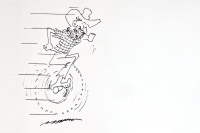Time for spring migrants in the mountains
 The cove we live in has been alive with birds for several weeks now. As alive with birds as it’s ever been — and we’ve lived at the same place for 40 years.
The cove we live in has been alive with birds for several weeks now. As alive with birds as it’s ever been — and we’ve lived at the same place for 40 years.
Most of these are common “residents”: goldfinches, cardinals, song sparrows, towhees, blue birds, Carolina wrens, white-breasted nuthatches, Carolina chickadees, titmice, phoebes, etc.), although we’ve had an inordinate number of pine siskins, which I suppose could be quantified as “winter residents” that occasionally breed in the southern Appalachians.
Some of what I categorize as “short-range” migrants (brown thrashers, catbirds, red-wing blackbirds, etc.) have already arrived back in the mountains or will do so soon. As a matter of fact, not all of these leave the mountains except during very cold winters, when they slip down into South Carolina, Georgia and Alabama for a brief respite.
Several of the “middle distance” migrants have arrived from the Atlantic and Gulf coasts, the most notable being tree swallows and blue-headed vireos, which we heard singing along the ridge line above the cove last week.
Birds, especially “long-distance” migrants from Central and South America, are creatures of habit. They have to be; otherwise, they could never arrive on their wintering or breeding grounds at the right time. Every year purple martins, the first of the “long distance” species to arrive, appear in Bryson City on or about March 15.
We have for years used Arthur Stupka’s Notes on the Birds of Great Smoky Mountains Park (University of Tennessee Press, 1963) for reliable information on earliest spring arrival and fall departure dates. (Unfortunately, this book is now out of print, but multiple used copies are often available via www.bookfinder.com. and similar Internet vendors). Marcus Simpson’s Birds of the Blue Ridge Mountains (UNC Press, 1992) is also useful in this regard, as is Fred Alsop’s Birds of the Smokies (Great Smoky Mountain Association, 1991).
The days between now and the first of April will bring chimney swifts, whip-o-wills, black-and-white warblers, and Louisiana water-thrushes (a warbler). The early and middle days of April will bring northern parulas (a warbler), palm warblers, and ruby-throated hummingbirds. The hummers are as punctual as the martins, except they come a month later on or about April 15.
Then in late April and early May the floodgates will open with warblers, thrushes, orioles, tanagers and other “long distance” species arriving here to breed or passing through headed for more northerly breeding grounds — in some instances, so far north as the Arctic.
Mel Baughman’s Reference to the Birds of North America (National Geographic, 2003) provides descriptions and maps for the spring and fall migration routes of many species. One of the most remarkable migrations — not only for birds but for the entire animal kingdom — is that of the blackpoll warbler, which will pass through Western North Carolina from very late April into Mid-may having already traveled from wintering grounds in northeastern South America and the Caribbean on its way to breeding grounds in the boreal forests of Canada and Alaska.
Many species make a flight of a few hundred miles over the Gulf of Mexico to return to South America in a day or so. The blackpoll warbler opts for a trans-Atlantic flight of more than 1,700 miles.
After breeding they return to the east coast of Canada or New England, where they gorge themselves so as to nearly double their body mass. From here they lift off from the continent and fly southeast over the Atlantic toward Bermuda. Somewhere hundreds of miles off the southeastern coast of the United States they catch winds that carry them with a minimal expenditure of energy back to their wintering grounds.
I haven’t done the math except in a rough fashion, but some of these birds that breed as far west as Alaska must log up to 3,000 miles round trip.
(George Ellison is a naturalist and writer. He can be reached at This email address is being protected from spambots. You need JavaScript enabled to view it..)





